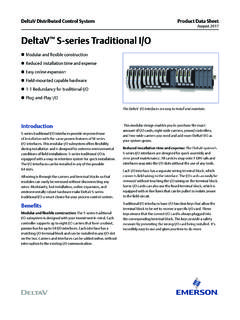Transcription of DeltaV™ Sequence of Events - Emerson
1 deltav Distributed Control SystemWhite PaperOctober 2016 deltav Sequence of EventsThis document describes how the deltav system captures and communicates Sequence of Events messages. It also addresses how the system manages the time synchronization required to accurately Sequence Events that are read by different controllers in the deltav system. M-series SOE Input Cards and Controller are shown exemplary here. S-series SOE Input Cards and Controller are physically different regarding their housing and the 2-wide carrier Controllers are placed on, but they will behave the same way, as explained in this Sequence of EventsOctober of ContentsIntroduction.
2 Capturing Events ..Communicating Events ..Synchronizing the Network ..Displaying Events ..Summary ..334568 deltav Sequence of EventsOctober what happened before, during and after a process upset is fundamental in identifying what caused the upset to occur as well as in determining how it could be prevented in the future. Accurately recording the Events that took place - in the precise order in which they occurred allows those investigating the incident to have an exact picture of the chain of Events that led to the upset. Within deltav , these types of Events especially those involving high-speed equipment are captured by the Sequence of Events (SOE) input card and are displayed in Process History View.
3 Controllers and workstations are synchronized throughout the entire deltav system using a Network Time Protocol (NTP) server. This allows SOE input cards to be distributed among multiple controllers, while ensuring that the Events are properly EventsThe deltav system receives process-upset signals using the SOE input card. There is no limit to the number of SOE cards that can be used. Every card has 16 discrete input channels and each channel is configured with four key pieces of information; Description, Channel type, Device Tag, and a State Named Set. The description and state named set are used to formulate the event message that is displayed in Process History View.
4 The channel type determines how the signal is handled by the system and the device tag defines the name of the device sending the incoming the Channel type field, each channel can be configured as either a standard discrete input or as an SOE discrete input. Regardless of whether the input channel on an SOE card is configured as a standard discrete or an SOE discrete, it can be used as part of any control strategy, just like any other discrete signal coming into the system. A channel that is configured to capture SOE discrete inputs reads the incoming signal and determines when to generate an event based on the behavior of the signal. Events are generated every time a signal changes from one state to the other (Note: A 4ms filter is used to debounce the signal).
5 Using the State Named Set configured for the channel, the state of the signal is translated from a discrete value into a more readable form and inserted into the event message. Event messages are sent from the SOE input card to the controller where they are then communicated to a designated Event Chronicle. From there, the event is distributed to other Event Chronicles throughout the entire deltav 1 M-series SOE input cards use the behavior of the input signal to determine when to generate event Sequence of EventsOctober EventsAll of the controllers in the deltav network send their respective SOE messages to a designated Event Chronicle where the messages are stored in the event journal along with all of the other alarms and Events being collected on that workstation.
6 Even though the Event Chronicle on any deltav workstation may be used to collect SOE messages, deltav only allows one Event Chronicle at a time to be designated as the SOE collection node. The SOE collection node is responsible for: Ensuring that the SOE messages are stored, Sending confirmation to the SOE input cards when a message has been successfully stored, and Communicating the SOE messages to other Event Chronicles throughout the deltav property of each Event Chronicle is used to define whether that particular workstation will serve as the SOE collection messages are time-stamped by the SOE input card using a -ms resolution. The messages are passed in groups to the controller where they are then synchronized with messages coming from other SOE input cards before being sent on to the SOE collection node.
7 Until the controller receives confirmation that an event has been successfully acknowledged by SOE collection node, the event will remain in a buffer on the SOE input card where it originated. Up to 32 Events can be buffered on each SOE input card. If the buffer is already full and an additional event is generated then an overflow event is recorded. Also, in the event of a switchover, even if the Events in the controller are lost, the secondary controller will be able to retrieve them from the buffer in each card and send them to the designated Event : Because Events are acknowledged before they are written to disk, the workstation where the Events are stored must have a UPS or secure power source to ensure the Events persist through power 2 Event messages are sent to a designated Event Sequence of EventsOctober addition to Events generated by SOE inputs, the controller is also capable of producing other SOE-related event messages that are used to indicate that a specific condition has been met.
8 The following table describes each of the additional 1. List of additional SOE-related Events the controller can generateEvent MessageDescriptionStart ChatteringGenerated whenever an SOE discrete input channel goes into chatter mode. *Stop ChatteringGenerated whenever an SOE discrete input channel leaves chatter mode. *Card Queue OverflowGenerated whenever the SOE input card generates the 33rd unacknowledged Out of Time SynchronizationGenerated whenever a controller that is receiving data from an SOE discrete input channel is more than 1 ms out of sync with the master timeserver. Controllers not being used to read SOE inputs will not generate these Events .
9 * Each channel is configured to either detect or ignore chattering on the input signal. This message will only be generated when the channel has been configured to detect Events are read by the controller, the controller finishes formatting the event messages before sending them on to the SOE collection node. It uses the respective State Named Sets and descriptions that were configured for each channel to formulate the event message that will be viewed in Process History controller also resolves the event message time stamps using a Network Time Protocol (NTP) server. Each controller in the network synchronizes with the NTP server to ensure that it is within +/- 1ms of the server.
10 This ensures that Events generated on different SOE input cards on different controllers are accurately the NetworkIn order to Sequence all of the incoming Events in the precise order in which they occurred, there must be a way to ensure that the elements of the system that are responsible for generating, time stamping and communicating these Events are properly synchronized. For SOE messages generated in deltav , this is accomplished using an NTP is a standard communication protocol that allows computers to synchronize with a timeserver across a network. An NTP timeserver is used in deltav to ensure that the time clocks on all of the controllers and workstations are synchronized with each other based on a common reference time source.












